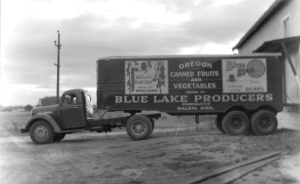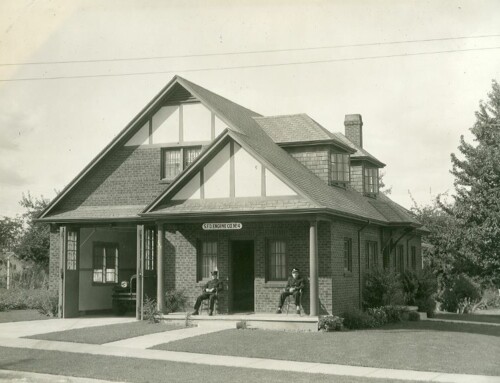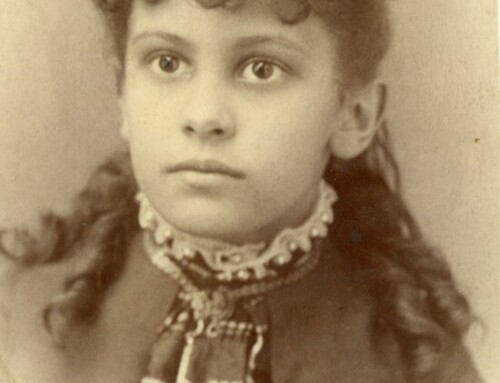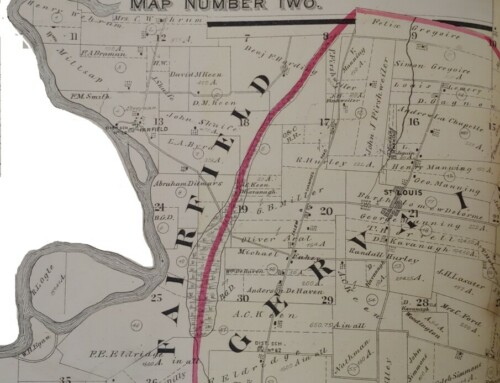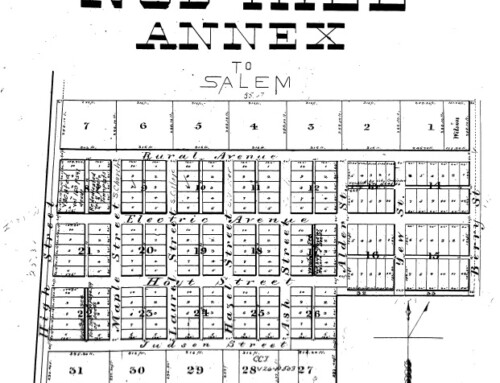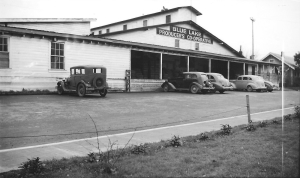
Blue Lake Producers Cooperative 325 Patterson Ave. West Salem – Photo Credit: PCHS – Bill Lucas Collection
All because a great American comedian, Lou Costello, saw promotion possibilities where the publicity directors of Warner Bros. studios didn’t, a Salem industry and the city of Salem itself became national news. It was a fairytale dream come true for the owners of the Blue Lake Packers, a cannery whose humble origins began during the Great Depression with a small group of farmers. The group possessed little or no physical assets or finances, but under the vision of Oka E. Snider, a fellow farmer, the group formed the West Stayton Packing Company to grow beans to be processed at the Cleary-Hillman Packing Company which was located at 325 Patterson Ave. in West Salem. The group was quality conscious from the beginning and with the cooperation of several seed companies they became the first co-op and cannery to grow and pack “100% Stringless Blue Lake Beans.” Later beets, corn, carrots, berries and cherries were added to the list production line. Pulling themselves up by their bootstraps, the farmer’s cooperative retained control of their product by marketing on a percentage basis, keeping control of sales and the selling price. Within two years they purchased one-half of the common stock at the Cleary-Hillman Company and began setting up their own direct selling connections, then on May 25, 1938 they purchased the remaining company stock and took over the cannery, changing the name to “Blue Lake Producers, Cooperative.” They suffered a devastating setback on December 31, 1944, when the cannery burned to the ground during the height of the war effort, but re-built within the year; a tough feat with wartime shortages. In 1946, they changed their name to Blue Lake Packers, Inc. By 1952, twenty years from their initial partnership, the Blue Lake Packers board of directors decided it was time to celebrate. At their annual meeting in February of that year they designated 1952 the Jack and the Beanstalk year after their most profitable label line and decided to pursue national advertising. Little did they know that Lou Costello and Warner Bros. Studio were working on their own Jack and the Beanstalk project and would soon come calling. Paul Colwell, the Blue Lake broker for the Los Angeles area was the first to see the possibilities. He heard that Warner Bros. Studio was filming the comedy team of Abbott and Costello in a picture titled “Jack in the Bean Stalk.” Colwell pitched them an idea, why not tie-in Jack and the Beanstalk green beans? The studio was interested, but wanted a staggering price from the cannery to be involved. Colwell joked at the time that the studio not only wanted the packing company, but a congressional appropriation to boot in order to enter into the deal with Blue Lake. He walked away from the meeting and promptly forgot about it. A few months later the studio called him. Why hadn’t he been back? C’mon down they said, we’re ready to make a deal. Colwell went to the meeting. Lou Costello was there and what he had to say caused M. W. Merrill, sales manager for the packing company to fly from Salem to L.A. and they both listened to the comedian – who wasn’t being funny, just sensible. Costello had a whale of an idea. When Lou Costello learned that Jack and the Beanstalk was the name of a brand of green beans, he got such a kick out of the idea that he went to bat for the tie-in deal. But what will it cost? Colwell and Merrill wanted to know, wary after the first studio proposal. Said Costello, “Listen. It won’t cost you anything. This tie-in, with the Jack and the Beanstalk label in grocery stores and eating spots all over the country will help the picture more than the picture will help you boys.” Merrill made a unique merchandising deal with Costello and Warner Bros. Studio. As a result the cannery label appeared prominently all over the country where Blue Lake Packers’ canned goods were distributed.
Special posters were made up for display in grocery stores and theaters, special merchandising displays of green bean cans were placed in theaters showing the Hollywood version of the famous tale, including the Capitol Theater in Salem. Abbott and Costello made personal appearances in a lot of newly-opening markets where Jack and the Beanstalk beans were being featured. Lou Costello personally spent more than $1000 in air express charges sending cases of Blue Lake Jack and the Beanstalk beans to 43 nationally-known radio commentators and journalist friends throughout the nation. And do you remember the giant’s breakfast in the famous tale, all the eggs that Jack had to fry for him? Well, courtesy of the National Poultry and Egg Board, 50 million Blue Lake labels went all over the nation on exactly that many cartons of eggs featuring the giant’s breakfast. For the Blue Lake Packers it was a fairytale ending to their 20th anniversary year, never to be forgotten thanks to a quality product with a label that caught the eye and tickled the funny bone of a famous comedian.
This article was written by Kaylyn F. Mabey for the Statesman Journal where it was printed 18 January 2015. It is reproduced here for reference purposes.
References:
- “Stayton to Boston Flight Waits Winner of Contest” Daily Capitol Journal (Salem, OR) – Jul 1, 1949 p. 10
- “Jack and the Beanstalk in Big Publicity Feature” – Capitol Journal, May 1, 1952
- “Valley String Beans Promoted By Jack and Bean Stalk Movie” – Statesman May 2, 1952
- Blue Lake Packers Cooperative – Twenty-First Anniversary 1932-1953 Commemorative booklet
- Polk County Historical Society – subject files “Blue Lake Cannery Cooperative”
- “Canning in the Valley” (book) – Bill Lucas



